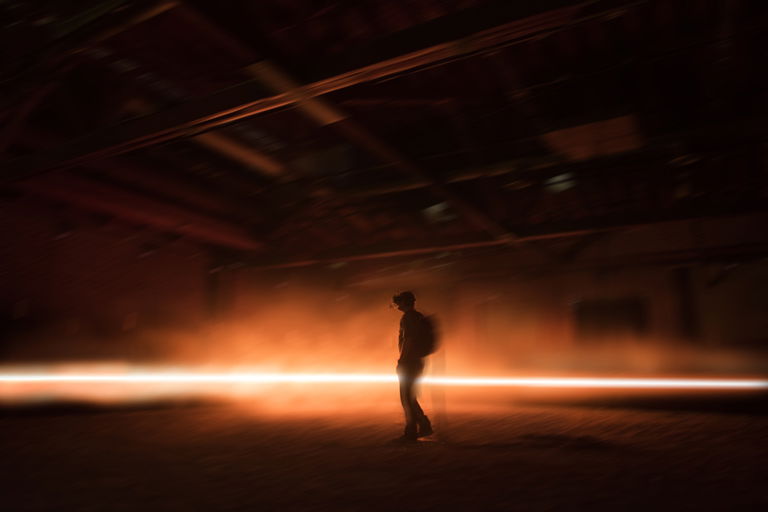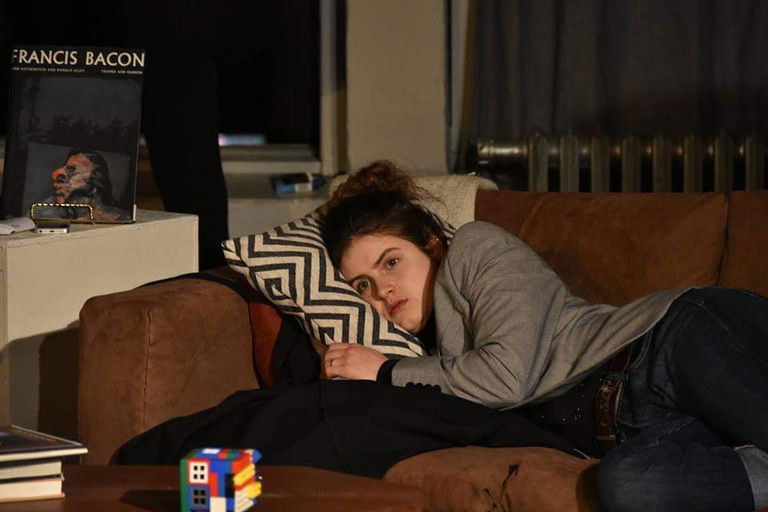
Empathy Machines?: Exploring the Relationship between Immersive Art Technologies and Feeling
Jozef Spiteri and Sunita Nigam for Culture Days
Sep 9, 2021
In Alejandro G. Iñárritu’s immersive virtual reality installation Carne y Arena (Virtually Present, Physically Invisible) (translated as Flesh and Sand), visitors sit in a cold metal room where they are forced to surrender their shoes. Next, they walk into a room filled with sand where they are given a backpack and a VR rig and plunged into a 20-minute immersive experience that mimics a U.S. Border Patrol raid between Mexico and the United States. At the end of the experience, as virtual migrants are ushered into armored vehicles, an agent points his gun at the visitor, demanding that they get on their knees.
Carne y Arena, co-produced by PHI Centre, a Montréal-based organization, belongs to a larger tradition in immersive VR art that has been emerging for the past 15 years, in which artists use technology to create experiences designed to make real-life spaces of human rights violations virtually available to wide audiences. Another recent example of the activation of immersive technologies to bring audiences into such spaces is the Museum Of Art and Design’s (MOAD’s) 2020 exhibit Forensic Architecture: True to Scale, which uses VR, architectural software and a collective of experts, to investigate human rights violations. Sophie Landres, curator of public programs at MOAD describes Forensic Architecture as a matrix for “interdisciplinary partnerships committed to learning about—and through—the technologies that mediate our realities.”

And indeed, a number of art institutions have spied in VR a radical potential to train audiences’ eyes on experiences and populations that are too often made politically invisible, or which are spatially and visually marginal to the spaces in which many of us carry out our everyday lives. As Vashti DuBois, founder of Philadelphia’s The Colored Girls Museum (TCGM) tells Immerse News, “As a new museum intent on serving a historically overlooked audience, we recognize the enduring power a VR web museum will have in making our real-life space accessible to wide audiences online whose lives, stories and images are traditionally excluded from American institutions. We intend to uplift hidden histories and lived experiences through technology.” As is demonstrated by Carne y Arena, some virtually-enhanced installations are taking as their mission making the viewer look, even and especially in moments in which they would be inclined to turn away, or in which things get just too painful to watch. Increasingly, immersive VR is being mobilized to make certain political situations impossible to ignore by immersing the audience’s visual and sensorial fields.
The question that this growing trend in immersive art technologies begs is, What for? Presumably, the goal of immersing visitors in sensorially enthralling, technologically heightened experiences of human rights violations, physical danger, and the otherwise uncomfortable or terrifying real-life experiences of others is, at the very least, to provoke an empathetic response and, at the very most, to serve as a call to action. Clare Patey and Roman Krznaric’s exhibit A Mile in My Shoes, created for Patey’s larger project “The Empathy Museum,” foregrounds the production of empathy as its ultimate goal in the very title of the exhibit and museum. In A Mile in My Shoes visitors are invited to choose from a collection of shoes and to walk a mile in them while listening to stories through a set of headphones. The shoes belong to a diverse selection of individuals, including a Syrian refugee, a sex worker, a war veteran, and a neurosurgeon and the stories narrate the lives and experiences of these shoe-owners. In taking its visitors through a narrative and physical journey, the exhibit seeks to provoke an empathetic experience in the visitor, through which they can share in the feelings of others.
To be sure, through the multi-sensory capacities of immersive technology we can walk in another’s literal and figurative shoes, and absorb the stories of others in whole new ways. But the larger assumption at work in pieces like Carne y Arena, Forensic Architecture, and A Mile in My Shoes, is that technologically-enhanced immersive art is better suited to the project of producing experiences of empathy in the audience than less sensorially immersive forms. Is this assumption fair?
By stimulating multiple senses at the same time, immersive art seeks to transport visitors out of the world of the everyday into an artistically heightened experience of bodily immersion. Instead of addressing audiences as passive viewers whose job it is to consume external content, immersive art seeks to create the impression that the visitor is “entering into” the work of art.
As the use of immersive art technologies overlap with political artistic projects of empathy and activism, it seems the logic at play is that by engaging the visitor’s body more fully to interact with the experiences of other and even blur the lines between self and other, it is also possible to activate an “empathy muscle,” that unleashes feelings of closeness, consideration, and care. In turn, the logic seems to follow, by producing more empathetic citizens, immersive art technologies might even have the power to bring about more equitable and inclusive futures.
Neuroscientific research on empathy does suggest that empathy can be grown through experiences of trying to occupy another’s perspective and of imagining how another might be feeling, especially through reading body language and other non-verbal cues. In their engagement of multiple senses to make the audience interact with the experiences of others, it might be true that immersive art technologies are especially well-poised to provoke experiences of empathy. But leading research on empathy also insists on the importance of regular feedback from other people as a factor in building empathetic capacities; this ensures that we are not simply projecting our own feelings onto others, but actively engaging with their responses to our attempts at empathy. Because this kind of feedback is not consistently built-in to immersive art experiences, these experiences run the risk of becoming focal points for inaccurate and even harmful projections and assumptions. They also run the risk of merely being trauma porn, or “media that showcases a group’s pain and trauma in excessive amounts for the sake of entertainment.” (Brittany J. “What Trauma Porn Is, and Why It Hurts Black People”).

Even if immersive art technologies are particularly apt for producing experiences of empathy in audiences, what proof do we have that, after being immersed in fragments of the unsettling realities of others, these experiences will go on to have any influence on their actions as citizens and political subjects? This is a question worth taking seriously by audiences and art institutions alike as the latter tout immersive art technologies as would-be empathy machines that can open up horizons to a better world. This question also speaks to the temporality of immersive experiences. Are these experiences somehow “over” once we fall back into step with the rhythms of our everyday lives? Or do they have (and perhaps especially so for their multi-sensorial stimulation of our bodies) staying power that carries forth into our future actions and decisions? Moreover, is there a hidden danger in investing in the notion that having empathetic feelings towards another person or group is or should be a requirement for protecting their human rights? Are a person’s human rights not worth protecting even if we are not able to experience empathy for them?
While it is exciting that artists are mobilizing immersive technologies like VR to make tangible politically invisibilized experiences of marginalized populations and human rights violations, many questions remain about the relationships between immersion, empathy, and political action. Rather than taking the assumptions promoted by arts institutions about the utopian potential of their exhibits at face value, let’s keep putting pressure on questions about how, precisely, immersive arts technologies enter the realm of the political and activate alternative futures.
Cover image: Museum Of Art and Design’s (MOAD’s) 2020 exhibit “Forensic Architecture: True to Scale”. Photo courtesy of the authors.
This article is part of a special blog series featuring writers and creatives from across Canada (and beyond!) with stories that both highlight and celebrate Culture Days’ 2021 theme, RE:IMAGINE. Explore more stories below.
- The Road Less Travelled: Three artists reimagine success and career by Linh S. Nguyễn
- Arts in Motion by Aaron Rothermund
- Reimagining Public Spaces: The Share-It-Square in Portland, Oregon by Laura Puttkamer
- Refresh: How a Year on Instagram Redefined Artistic Communities by Eva Morrison
- RE:PURPOSE by Mike Green
- Recalibrating: A Look at Opera InReach by Anya Wassenberg
- Reimagine—How the Disability Community Accesses the Arts by Rachel Marks
- Reimagining Community and the Workplace of Theatre by Natércia Napoleão
- Helm Studios flips the for-profit music model to empower artists by Aly Laube
- Curating INUA, Canada’s newest Inuit art exhibit by Carolyn B. Heller
- When Less is More: What Theatre Can Learn From a Year in Slow Motion by Megan Hunt
- RE:ORCHESTRATING Our Future: Advancing Sustainable Development Through the Arts by Ryan Elliot Drew
- RE:DEFINING Normal: A Prescription for a Canadian Cultural Landscape in Recovery by Valerie Sing Turner
- La poésie pour vivre différemment la pandémie par Jérôme Melançon




